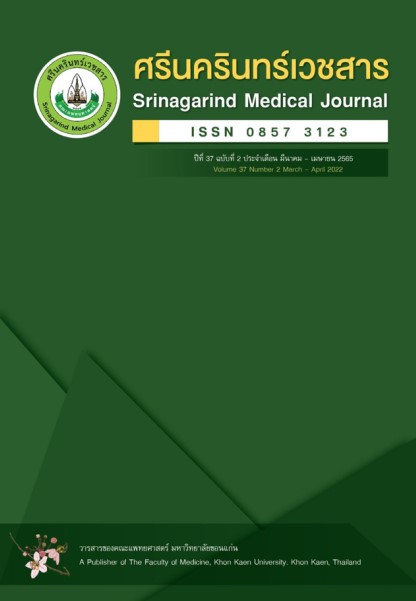สัดส่วนและความเร็วในการเดินของผู้ที่มีความสามารถด้านการเดินระดับต่าง ๆ
Abstract
Proportion and Walking Speed of Individuals with Various Walking Ability
หลักการและวัตถุประสงค์: ความผิดปกติด้านการเดินส่งผลต่อความเร็วในการเดิน แต่ปัจจุบันยังไม่มีรายงานสัดส่วนความสามารถและความเร็วในการเดินของผู้ที่มีความบกพร่องด้านการเดินจากประเทศกำลังพัฒนา ดังนั้น การวิจัยนี้จึงรายงานสัดส่วนและความเร็วในการเดินของผู้ที่มีความสามารถด้านการเดินกลุ่มต่าง ๆ
วิธีการศึกษา: อาสาสมัคร จำนวน 53 ราย ได้รับการสัมภาษณ์เพื่อแบ่งกลุ่มความสามารถในการเดินออกเป็นความสามารถในการเดินเพื่อประกอบกิจวัตรประวันและเดินในชุมชน และประเมินความเร็วในการเดินระยะทาง 10 เมตร
ผลการศึกษา: อาสาสมัครส่วนใหญ่สามารถเดินทำกิจวัตรประจำวันได้ (ร้อยละ 87) และสามารถเดินในชุมชนได้ (ร้อยละ 81) โดยความเร็วในการเดินของการศึกษานี้มีความแตกต่างจากข้อมูลที่รายงานจากการศึกษาของประเทศที่พัฒนาแล้ว นอกจากนี้ อาสาสมัครที่มีความสามารถในการเดินไม่ดีมีความเร็วปกติและความเร็วสูงสุดใกล้เคียงกัน (ค่ากลางความแตกต่างของความเร็ว 0.01 เมตร/วินาที) ในขณะที่อาสาสมัครที่มีความสามารถดีมีความเร็วในการเดินแตกต่างกันอย่างชัดเจน (ค่ากลางความแตกต่างของความเร็ว 0.25 เมตร/วินาที)
สรุป: ผลการศึกษานี้แนะนำการศึกษาเพิ่มเติมเพื่อให้ได้ข้อมูลความเร็วในการเดินสำหรับการอ้างอิงและติดตามการเปลี่ยนแปลงความสามารถอย่างจำเพาะสำหรับผู้ที่มีความบกพร่องด้านการเดินจากประเทศกำลังพัฒนาต่อไป
คำสำคัญ: การเดิน, การเคลื่อนไหว, อุปกรณ์ช่วย, กายภาพบำบัด, การฟื้นฟูความสามารถ
Background and Objectives: Walking disorders are commonly affected walking speed. However, there is no evidence on the proportion and walking speed of individuals with walking impairments from a developing country. Therefore, this research reported the proportion and walking speed of individuals with various walking ability.
Methods: Fifty-three participants with various walking ability were interviewed to arrange their walking ability from their functional walking and ability to participated in community. Then, they were assessed for walking speed using a 10-meter walk test.
Results: Most participants could walk functionally (87%) and were full community ambulators (81%). Their walking speed were difference from the data reported of developed countries. In addition, participants with poor walking ability had only slight differences in preferred and fastest speed (median speed difference of 0.01 m/s). In contrast, participants with good ability had obvious speed differences (median speed difference of 0.25 m/s).
Conclusion: The present findings suggest the need for a further study to explore walking speed for referencing and monitoring the change of ability particularly for individuals with walking impairments from a developing country.
Keyword:Walking, Mobility, Walking device, Physical therapy, Rehabilitation


